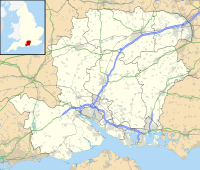Southampton Castle
| Southampton Castle | |
|---|---|
| Hampshire, England | |

The castle portrayed by John Speed in a map of 1612
|
|
| Coordinates | 50°54′03″N 1°24′19″W / 50.9007°N 1.4054°WCoordinates: 50°54′03″N 1°24′19″W / 50.9007°N 1.4054°W |
| Grid reference | grid reference SU41911141 |
| Type | Motte and bailey, later shell keep |
| Site information | |
| Condition | Destroyed, with isolated remains |
| Site history | |
| Materials | Stone |
| Battles/wars | French raid of 1338 |
Southampton Castle was located in the town of Southampton in Hampshire, England. Constructed after the Norman conquest of England, it was located in the north-west corner of the town overlooking the River Test, initially as a wooden motte and bailey design. By the late 12th century the royal castle had been largely converted to stone, playing an important part in the wine trade conducted through the Southampton docks. By the end of the 13th century the castle was in decline, but the threat of French raids in the 1370s led Richard II to undertake extensive rebuilding. The result was a powerfully defended castle, one of the first in England to be equipped with cannon. The castle declined again in the 16th century and was sold off to property speculators in 1618. After being used for various purposes, including the construction of a Gothic mansion in the early 19th century, the site was flattened and largely redeveloped. Only a few elements of the castle still remain visible in Southampton.
Southampton Castle was first constructed in the late 11th century, at some point after the Norman conquest of England. Southampton at this time was a relatively large town, but not as significant as in the later medieval period. The royal castle was erected within the existing town on the site of a probable large English hall, and considerable damage was caused to the surrounding local buildings as space was opened up for the new fortification. The town of Southampton was protected by water on most sides, surrounded by protective ditches and banks, and the castle was built on rising ground in the north-west corner of the town, overlooking the mouth of the River Test, an important medieval waterway. The initial castle was a timber motte and bailey design, with a motte 45 feet (14 metres) across; at least some of the bailey walls were rebuilt in stone during the first half of the 12th century. The wealthiest parts of Southampton were in the west of the town, just to the south of the castle, with some of the poorest districts just beyond the castle to the north-east. The castle was positioned so as to adjoin the town's quays.
...
Wikipedia

